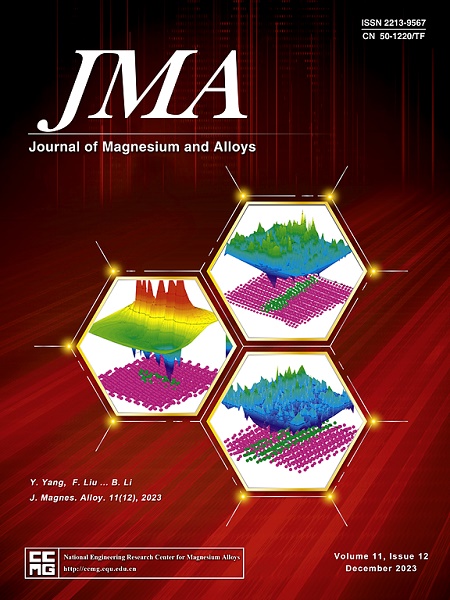Synthesis of organic-inorganic 3D-nanocontainers for smart corrosion protection of friction stir welded AZ31B magnesium alloy-titanium dissimilar joints
IF 13.8
1区 材料科学
Q1 METALLURGY & METALLURGICAL ENGINEERING
引用次数: 0
Abstract
The joining of different light metals through friction stir welding (FSW) is gaining interest as a method to decrease weight and improve fuel efficiency. However, to ensure durability, these welded metals may require surface treatments to protect against corrosion or wear. This study presents a novel approach for the simultaneous delivery of two distinct corrosion inhibitors to Ti-Mg dissimilar PEO treated joints on demand. The research focuses on the synthesis, characterization, and application of cerium@polystyrene (Ce@PS) nanocontainers, which are loaded with 8-hydroxyquinoline (8-HQ) to enhance corrosion protection. The synthesis involves several key steps, including the formation of a cerium-based outer layer around polystyrene nanospheres, the selective removal of the polystyrene core to create a porous structure, and the subsequent loading of the 8-HQ inhibitor. Structural and compositional analyses, conducted using scanning transmission electron microscopy (STEM) and energy-dispersive X-ray spectroscopy (EDS), confirmed the successful incorporation of 8-HQ within the nanocontainers. Additionally, Fourier-transform infrared spectroscopy (FTIR) provided detailed information about the chemical composition of the organic materials throughout the synthesis process. Thermal decomposition analysis verified the successful fabrication and stability of the dual-shell nanocontainers.
Corrosion tests on Ti-Mg joints treated with plasma electrolytic oxidation (PEO) coatings and loaded nanocontainers demonstrated significantly improved corrosion resistance compared to untreated joints. This research highlights the potential of dual-shell nanocontainers, containing both organic and inorganic inhibitors, to offer prolonged corrosion protection, particularly against galvanic corrosion in dissimilar joints. The findings suggest that these synthesized nanocontainers hold promise for various industrial applications, particularly in the context of friction stir welded (FSW) Ti-Mg dissimilar joints, providing valuable insights for the development of advanced materials designed to mitigate corrosion.


为搅拌摩擦焊接 AZ31B 镁合金-钛异种接头的智能腐蚀保护合成有机-无机三维纳米容器
通过搅拌摩擦焊(FSW)连接不同的轻金属,作为减轻重量和提高燃油效率的一种方法,正受到越来越多的关注。然而,为了确保耐久性,这些焊接金属可能需要进行表面处理,以防止腐蚀或磨损。本研究提出了一种按需同时向钛镁异种 PEO 处理接头输送两种不同腐蚀抑制剂的新方法。研究的重点是铈@聚苯乙烯(Ce@PS)纳米容器的合成、表征和应用,该纳米容器装载了 8-羟基喹啉(8-HQ)以增强腐蚀保护。合成涉及几个关键步骤,包括在聚苯乙烯纳米球周围形成铈基外层、选择性去除聚苯乙烯核心以形成多孔结构,以及随后载入 8-HQ 抑制剂。利用扫描透射电子显微镜(STEM)和能量色散 X 射线光谱(EDS)进行的结构和成分分析证实,8-HQ 成功地融入了纳米容器中。此外,傅立叶变换红外光谱(FTIR)提供了整个合成过程中有机材料化学成分的详细信息。对使用等离子电解氧化(PEO)涂层和负载纳米容器处理过的钛镁接头进行的腐蚀测试表明,与未经处理的接头相比,耐腐蚀性能明显提高。这项研究强调了含有有机和无机抑制剂的双壳纳米容器在提供长期腐蚀保护方面的潜力,特别是在异种接头的电化学腐蚀方面。研究结果表明,这些合成的纳米容器有望用于各种工业应用,特别是在搅拌摩擦焊接(FSW)钛镁异种接头方面,为开发旨在减缓腐蚀的先进材料提供了宝贵的见解。
本文章由计算机程序翻译,如有差异,请以英文原文为准。
求助全文
约1分钟内获得全文
求助全文
来源期刊

Journal of Magnesium and Alloys
Engineering-Mechanics of Materials
CiteScore
20.20
自引率
14.80%
发文量
52
审稿时长
59 days
期刊介绍:
The Journal of Magnesium and Alloys serves as a global platform for both theoretical and experimental studies in magnesium science and engineering. It welcomes submissions investigating various scientific and engineering factors impacting the metallurgy, processing, microstructure, properties, and applications of magnesium and alloys. The journal covers all aspects of magnesium and alloy research, including raw materials, alloy casting, extrusion and deformation, corrosion and surface treatment, joining and machining, simulation and modeling, microstructure evolution and mechanical properties, new alloy development, magnesium-based composites, bio-materials and energy materials, applications, and recycling.
 求助内容:
求助内容: 应助结果提醒方式:
应助结果提醒方式:


